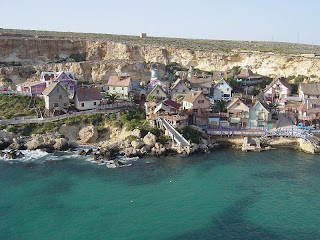Popeye Village
This fantastical Film Set found at the shores of one of Malta’s most picturesque locations, has just turned 30, and there seems to be no way it ever loses its appeal. Anchor Bay hosts this pristinely kept ramshackle sea-side village which housed the 6 month shoot of the musical Popeye in 1980. The late Robert Altman helmed the entire location shoot directing amongst others, Paul L. Smith as Cpt. Bluto, Shelley Duvall of The Shining as Olive Oyl, and introducing on the Silver Screen, Robin Williams as the one-eyed sailor himself.
The story follows Popeye in his search for his lost father, Poopdeck Pappy. He stumbles upon Sweet Haven village, befriends an eccentric Hamburger eater, Mr. Wellington Wimpy and rents a room from Olive Oyl’s, his soon to be love of his life. Enter the brute pirate Bluto and things get somewhat complicated. To cut a long story short, without detracting from this entertaining effort from the Eighties, Popeye manages to find his father and also a little surprise along the way.
Popeye’s motto has always been ‘I Yam what I Yam’, and this rings true to this very day. After all these years this ‘way of thinking’ has swept the entire village and all those who visit the Film Set are transported back in time, when the simple things were those which matter most.
All the buildings are kept in their original state, save some for added safety since they were only constructed to offer a backdrop for the shoot. Detailed attention is undertaken on a daily basis and the maintenance team is on the go 24/7. All this coupled with the ever-innovative management and you have a Village that lives and gains more and more popularity as time goes by.
Popeye Village, as it is widely known amongst the islanders, has been offering Amusement Park services for many years, hosting ‘Private Functions’, ‘Dance Parties’, ‘Weddings’ and even ‘Corporate Events’. Amongst today’s activities on offer one can find free Boat rides around Anchor Bay, Silver Smith demonstrations, Wine tasting, open-air beach Lido with shower and Baywatch attendant, little kids areas where you can rest assured the little ones will be amused with hours of fun and much more. All the animators will make sure you have a fantastic time whilst back to back animation shows pack the Village with colorful characters roaming around, transporting you back in time.
Join the thousands of repeat visitors and experience for yourselves the magic to be had at Malta’s only Family Fun Park, Popeye Village.



















